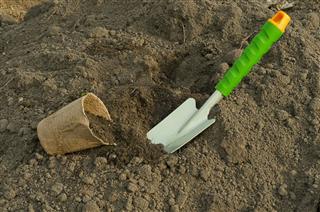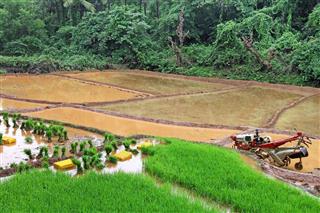
Basically, soil is classified into different types based on its composition. For instance, loam soil has 10 to 30 percent clay, 30 to 50 percent silt, and 25 to 50 percent sand. Sandy clay loam, on the other hand, has 20 to 35 percent clay, less than 28 percent silt, and more than 45 percent sand. Based on the components and the size of the particles, soil is classified into different types.
A rock, as we know, is made up of various minerals, metals, and fossils. Continuous exposure to natural and man-made factors causes the parent rock to weather. Over a period of time, these weathered rock particles form the top layer of soil, that plants use to grow and survive.
The size of soil particles is important. The amount of open space between the particles influences how easily water moves through soil, and how much water the soil will hold. Too much clay in proportion to silt and sand causes the soil to take in water very slowly. Such soils give water to plants slowly, and are sticky when wet.
Here is a soil triangle or texture triangle, which will help you understand soil classification on the basis of silt, sand, and clay content.
Major Soil Types
Particle size: 0.05 to 2mm
Defining Factors:
Large particles
Dry and gritty to touch
Easily drains water
Less water retention
Warm and airy
Even when wet, easily crumbles through the fingers
Lacks essential nutrients
Ideal for crops like:
Watermelons, Peanuts, and Peaches
Ideal for plants like:
Tulips, Cistus, and Hibiscus
Particle size: less than 0.002mm
Defining Factors:
Fine particles
Smooth when dry
Sticky when wet
Retains water
Drains poorly
Less spaces to let air pass
Rich in nutrients
Cool and dense
Ideal for crops like:
Leafy vegetables, Peas, Tomatoes, and Peppers
Ideal for plants like:
Roses, Heleniums, Asters, and Chaenomeles
Particle size: 0.002 to 0.05mm
Defining Factors:
Tiny particles
Slippery when wet
Not grainy or rocky
Extremely fertile
Retains water
Easily transported by wind and water
Good for agriculture purposes
Easily compacted
Ideal for crops like:
All vegetables and fruits
Ideal for plants like:
Yellow Iris, Milkweed, and Red Chokeberry
Particle size: Depends on the major component
Defining Factors:
Well-drained
Fertile
Mixture of sand, silt and clay
Retains water
Retains nutrients
Strong granular structure
Soft and crumbly
Easy to work with
Well aerated
Ideal for crops like:
Tomatoes, Carrots, Parsnips, and Potatoes
Ideal for plants like:
Roses, Amaryllis, Marigolds, and Zinnias
Defining Factors:
Dark brown in color
Soft and spongy to the touch
Contains acidic water
Rich in organic matter
Retains water
Stores nutrients
Not fertile
Improves soil buffering
Well aerated
Found in bogs
Mixed in soil to improve structure
Ideal for plants like:
Sphagnum Moss, Ericaceous Shrubs, and Sedges
Defining Factors:
Light in color
Lime rich soil
Stony
Severely dry in summers
Poor in nutrients
Warms quickly in summers
Porous
Highly alkaline
Free-draining
Ideal for plants like:
Honeysuckle, Jasminum, Rosa, and Geranium
Besides the above classification of soil, the next popular classification of soil is according to the pH level of soil. In this classification, soil is either acidic or alkaline, depending on the amount of humus, organic matter, and the underlying bedrock. But, no matter what the type it is, every soil has its own advantages and disadvantages.












